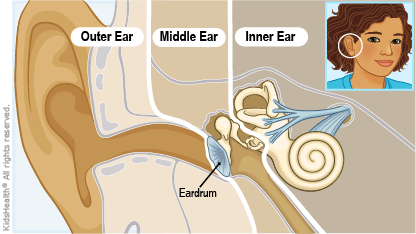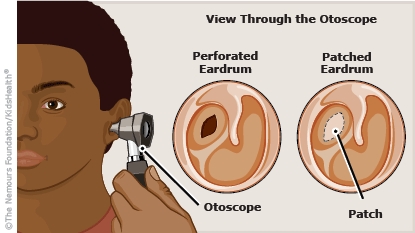- Parents Home
- Para Padres
- A to Z Dictionary
- Allergy Center
- Asthma
- Cancer
- Diabetes
- Diseases & Conditions
- Doctors & Hospitals
- Emotions & Behavior
- First Aid & Safety
- Flu (Influenza)
- Food Allergies
- General Health
- Growth & Development
- Heart Health & Conditions
- Homework Help Center
- Infections
- Newborn Care
- Nutrition & Fitness
- Play & Learn
- Pregnancy Center
- Preventing Premature Birth
- Q&A
- School & Family Life
- Sports Medicine
- Teens Home
- Para Adolescentes
- Asthma
- Be Your Best Self
- Body & Skin Care
- Cancer
- Diabetes
- Diseases & Conditions
- Drugs & Alcohol
- Flu (Influenza)
- Homework Help
- Infections
- Managing Your Weight
- Medical Care 101
- Mental Health
- Nutrition & Fitness
- Q&A
- Safety & First Aid
- School, Jobs, & Friends
- Sexual Health
- Sports Medicine
- Stress & Coping
Tympanoplasty
What Is a Tympanoplasty?
Tympanoplasty (TIM-pah-noh-plass-tee) is a surgery to repair the eardrum. The eardrum is a thin layer of tissue at the end of the ear canal that vibrates in response to sound.
Why Is a Tympanoplasty Done?
Doctors do a tympanoplasty when the eardrum (or tympanic membrane) has a hole that doesn't close on its own. It is done to improve hearing and prevent water from getting into the middle ear.
Kids can get a hole in an eardrum from:
- infections that cause the eardrum to burst
- ventilation (ear) tubes that fall out or are removed
- injury, such as puncturing the eardrum with a cotton swab
- cholesteatoma, a growth within or behind the eardrum
Most of the time, the eardrum can repair itself. So at first, doctors closely watch a hole in a child's eardrum rather than fix it right away. They might wait years to repair one in a very young child. This lets the ear develop enough to help prevent complications after the surgery. Surgery might also wait if a child has ongoing problems with ear infections.

What Happens Before a Tympanoplasty?
A child will have a hearing test before the surgery. This lets doctors compare the results with hearing tests done after the surgery.
How Should We Prepare for a Tympanoplasty?
Your health care provider will tell you what and when your child can eat and drink before the surgery. Your child's stomach must be empty on the day of the procedure.
You can help prepare your child and ease any fears by talking about what to expect during and after the tympanoplasty.
What Happens During Tympanoplasty?
An ear, nose, and throat (ENT) surgeon will do the tympanoplasty. Your child will get general anesthesia to sleep through the procedure. The anesthesiologist will carefully watch your child and keep them safely and comfortably asleep.
During a tympanoplasty, the hole in the eardrum is patched. The patch, also called a graft, can be made of:
- tissue taken from around your child's ear (or fascia)
- manmade material
The surgeon will put packing material behind and on top of the eardrum to keep the graft in place. This material dissolves over several weeks.

How Long Does a Tympanoplasty Take?
The operation usually takes from 30 minutes to 2 hours.
What Happens After Tympanoplasty?
The surgery team will give you care instructions. For example, your child might need to:
- avoid nose-blowing
- sneeze with the mouth open
- avoid getting water in the ear
- use ear drops, if prescribed
For about a week after surgery, your child may have:
- mild ear pain that gets better with pain medicine
- a small amount of blood or fluid draining from the ear
- a feeling of fullness in the ear
Usually, any packing placed in the ear will dissolve over time. At the first post-operative visit 2–3 weeks after surgery, the surgeon may try to remove any that is left. You can expect your child's hearing to improve over 2 or 3 months after the surgery. The surgery team will schedule a repeat hearing test 8–12 weeks after surgery.
Are There Any Risks From Tympanoplasty?
There's a very small risk of bleeding or infection from a tympanoplasty. Other risks include:
- graft failure
- hearing that doesn't improve or that gets worse
- ringing in the ear
- funny taste in the mouth
- dizziness
- skin getting trapped in the ear (cholesteatoma)
How Can Parents Help After Tympanoplasty?
To help your child after a tympanoplasty:
- Follow the surgeon's care instructions.
- Give your child pain medicine, when needed.
Make sure your child avoids:
- getting water in the ear
- heavy lifting
- vigorous exercise and contact sports
- any activities that may cause changes in pressure (swimming, diving, airplane travel)
Most children can return to regular activities a couple of days after surgery.
When Should I Call the Doctor?
Call your doctor if:
- You see fresh (bright red) blood on the bandage or packing, or steady oozing from the ear or incision.
- The ear or incision is more tender, red, or swollen than it was when your child left the hospital.
- Your child has a fever over 100.4°F (38°C).
- Your child's pain gets worse.

© 1995- The Nemours Foundation. KidsHealth® is a registered trademark of The Nemours Foundation. All rights reserved.
Images sourced by The Nemours Foundation and Getty Images.